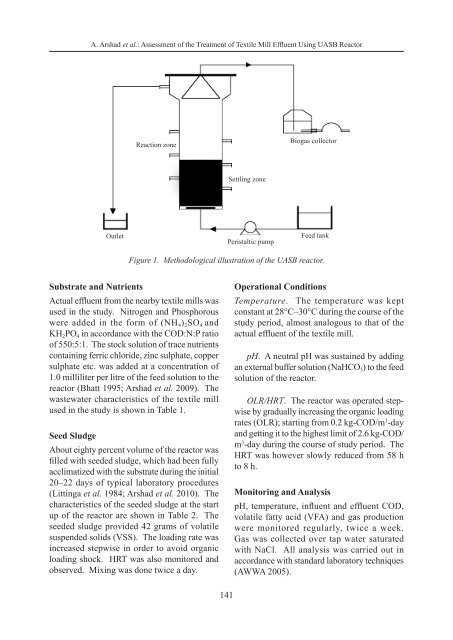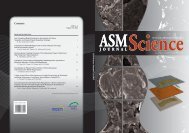in Negara Brunei Darussalam - Portal Rasmi Akademi Sains Malaysia
in Negara Brunei Darussalam - Portal Rasmi Akademi Sains Malaysia
in Negara Brunei Darussalam - Portal Rasmi Akademi Sains Malaysia
Create successful ePaper yourself
Turn your PDF publications into a flip-book with our unique Google optimized e-Paper software.
A. Arshad et al.: Assessment of the Treatment of Textile Mill Effluent Us<strong>in</strong>g UASB Reactor<br />
Reaction zone<br />
Biogas collector<br />
Settl<strong>in</strong>g zone<br />
Outlet<br />
Peristaltic pump<br />
Feed tank<br />
Figure 1. Methodological illustration of the UASB reactor.<br />
Substrate and Nutrients<br />
Actual effluent from the nearby textile mills was<br />
used <strong>in</strong> the study. Nitrogen and Phosphorous<br />
were added <strong>in</strong> the form of (NH 4 ) 2 SO 4 and<br />
KH 2 PO 4 <strong>in</strong> accordance with the COD:N:P ratio<br />
of 550:5:1. The stock solution of trace nutrients<br />
conta<strong>in</strong><strong>in</strong>g ferric chloride, z<strong>in</strong>c sulphate, copper<br />
sulphate etc. was added at a concentration of<br />
1.0 milliliter per litre of the feed solution to the<br />
reactor (Bhatt 1995; Arshad et al. 2009). The<br />
wastewater characteristics of the textile mill<br />
used <strong>in</strong> the study is shown <strong>in</strong> Table 1.<br />
Seed Sludge<br />
About eighty percent volume of the reactor was<br />
filled with seeded sludge, which had been fully<br />
acclimatized with the substrate dur<strong>in</strong>g the <strong>in</strong>itial<br />
20–22 days of typical laboratory procedures<br />
(Litt<strong>in</strong>ga et al. 1984; Arshad et al. 2010). The<br />
characteristics of the seeded sludge at the start<br />
up of the reactor are shown <strong>in</strong> Table 2. The<br />
seeded sludge provided 42 grams of volatile<br />
suspended solids (VSS). The load<strong>in</strong>g rate was<br />
<strong>in</strong>creased stepwise <strong>in</strong> order to avoid organic<br />
load<strong>in</strong>g shock. HRT was also monitored and<br />
observed. Mix<strong>in</strong>g was done twice a day.<br />
Operational Conditions<br />
Temperature. The temperature was kept<br />
constant at 28°C–30°C dur<strong>in</strong>g the course of the<br />
study period, almost analogous to that of the<br />
actual effluent of the textile mill.<br />
pH. A neutral pH was susta<strong>in</strong>ed by add<strong>in</strong>g<br />
an external buffer solution (NaHCO 3 ) to the feed<br />
solution of the reactor.<br />
OLR/HRT. The reactor was operated stepwise<br />
by gradually <strong>in</strong>creas<strong>in</strong>g the organic load<strong>in</strong>g<br />
rates (OLR); start<strong>in</strong>g from 0.2 kg-COD/m 3 -day<br />
and gett<strong>in</strong>g it to the highest limit of 2.6 kg-COD/<br />
m 3 -day dur<strong>in</strong>g the course of study period. The<br />
HRT was however slowly reduced from 58 h<br />
to 8 h.<br />
Monitor<strong>in</strong>g and Analysis<br />
pH, temperature, <strong>in</strong>fluent and effluent COD,<br />
volatile fatty acid (VFA) and gas production<br />
were monitored regularly, twice a week.<br />
Gas was collected over tap water saturated<br />
with NaCl. All analysis was carried out <strong>in</strong><br />
accordance with standard laboratory techniques<br />
(AWWA 2005).<br />
141

















